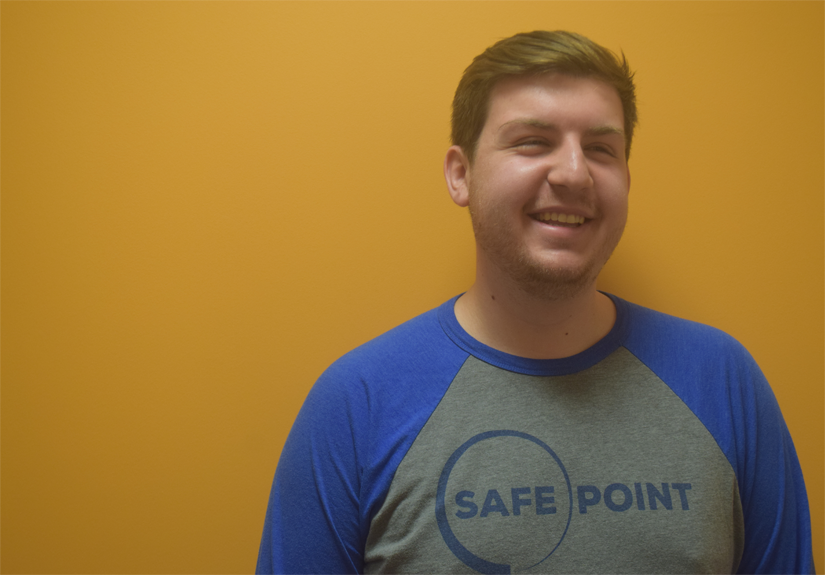A DOSE OF THE REAL WORLD: CPH student Ryan Yoder gets a head start on harm reduction
By Janaya Greene

Ryan Yoder’s volunteer work at Safe Point began with small tasks: transporting syringes, handing out brochures on HIV and Hepatitis and restocking tourniquets. A year and a half later, he’s one of only three staff members supporting one of Columbus’s comprehensive harm reduction program for intravenous drug use.
Yoder had no idea that volunteering at Safe Point would be the beginning of a much larger journey that would have an impact not only on the clients he served, but on him as well.
Upon enrolling at Ohio State, Yoder wanted to be a biochemist. His mom was a nurse at a drug detox center and Yoder had a passion for health, so majoring in biochemistry made the most sense.
"At the time, I was interested in medicine and how practitioners get to focus on people," says Yoder, a fourth-year undergraduate student of public health sociology at CPH. "That's what I was missing in the biochemistry curriculum: that interaction on how all of the information was applicable to population health."
Yoder merged his interests in population health and public policy by declaring a public health major and public policy minor. In spring 2016, Yoder took a class he would later learn had several opportunities for him to apply course curriculum to the real world.
“During my U.S. and International Healthcare course, I did a report on syringe service programs and their benefit to IV drug users and the community,” Yoder says. “Doing research for that paper is how I learned Columbus has the Safe Point program.”
“Safe Point has made me a better advocate for people’s health, for mental health, for substance abuse—which I’m really thankful for.” —Ryan Yoder, BSPH '18
He began volunteering at Safe Point that summer, joining a group of other College of Public Health faculty, staff and students who dedicate their time to the program.
Safe Point provides access to syringes, HIV and Hepatitis C testing, overdose prevention education, and more in an effort to decrease the spread of infectious diseases. The program also distributes the life-saving overdose-reversal medication naloxone to families and individuals at risk.
Rick Barclay has been an outreach specialist for Safe Point since its start of operations in 2016.
“People who use IV drugs are at a higher risk for HIV, Hep C and any other number of blood-borne illnesses,” Barclay says. “We make it less likely that these diseases are going to be transmitted in this population.”
Yoder’s dedication as a volunteer led him to a position on staff at Safe Point alongside Barclay. Yoder’s new role as an outreach specialist has given him a clearer view of how his talents can be applied in the field of public health.

Ryan Yoder (second from left) with Rick Barclay (right) and the rest of the staff at Safe Point.
“I’ve got to see Ryan go through the whole growing process and it’s been excellent,” Barclay says. “He has been able to figure out what we can do, in what span of time—realistically and effectively—and reduce the negative impact on people who use our program at the same time. He’s been really key in what we do.”
Yoder attributes the experience he has had at Safe Point as inspiration for how to continue his education, and how to launch his career.
He has been accepted to Johns Hopkins Bloomberg School of Public Health where he’ll pursue a master’s degree in health policy beginning in the fall. He then wants to launch a career focused on lessening the stigma of addiction and increasing drug treatment from a harm reduction route.
“Safe Point has made me a better advocate for people’s health, for mental health, for substance abuse—which I’m really thankful for.”
About The Ohio State University College of Public Health
The Ohio State University College of Public Health is a leader in educating students, creating new knowledge through research, and improving the livelihoods and well-being of people in Ohio and beyond. The College's divisions include biostatistics, environmental health sciences, epidemiology, health behavior and health promotion, and health services management and policy. It is ranked 22nd among all colleges and programs of public health in the nation, and first in Ohio, by U.S. News and World Report. Its specialty programs are also considered among the best in the country. The MHA program is ranked 5th and the health policy and management specialty is ranked 21st.